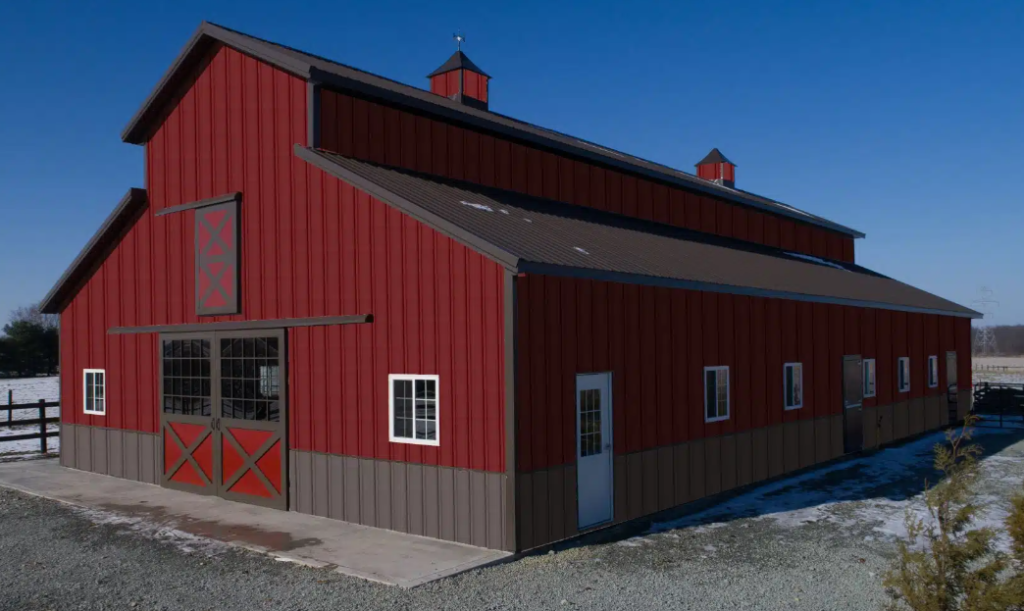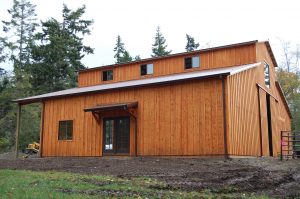Board & Batten Steel Siding
Board & Batten siding has seen a resurgence in residential and agricultural design in recent years, and rightfully so as many building and builders crave classical aesthetics of rural farmhouse design. A challenge, though, is wooden board & batten is still susceptible to rot, insect damage, cracking, and various other visual and functional problems.
Steel Board & Batten solves all these issues. This exceptionally durable siding system is set to redefine exterior appeal of residential and light commercial structures. Residential contractors and custom home builders, homeowners, commercial building owners, and architects and designers can now utilize steel’s strength and durability while imparting a welcoming and enduring character and delivering lasting value in fifteen painted and three wood grain finishes.
“The Central States Board & Batten product is beautiful, easy to install, and is something we are excited to offer to our clients,” said Jonathan Bucher, VP at Stoneburner Inc. “We sell a good amount of wood board and batten, but have been looking for years for a more durable, maintenance-free option. This product exceeds our expectations! Our initial installations look great and will last a lifetime.”
Steel board and batten is a cost-effective siding solution with superior durability over comparable systems as it brings a lifetime warranty and classic aesthetic to residential and commercial structures. A rising trend in residential design, leaning towards modern farmhouse or industrial chic aesthetics, has made this profile increasingly attractive to individuals who may not have previously considered metal siding or those whose communities might have restricted use of metal siding previously.
“Our customers have expressed a desire for a product that emulates the look of traditional exterior finishes with the added benefits of steel, and we are excited to meet that demand with excellence,” stated Tim Ruger, President of Central States Manufacturing. “As a 100% employee-owned company, we are dedicated to our customers and believe this product will introduce fresh possibilities for the advantages of steel for more building types in more communities.”
Central States Board & Batten siding is a superior option to other market products including engineered wood, fiber cement, and vinyl. These traditional materials have various downsides including mold, rot, sagging, limited flexibility, inferior weather resistance, and environmental concerns.
Metal board and batten eliminates needs for painting or repainting throughout its lifespan. As a most environmentally-friendly building material, steel is 100% recyclable, and dissipates heat, contributing to cooler interiors. Central States Board & Batten stands out for homeowners and designers alike, offering custom lengths up to 30’. Crafted from 26-gauge steel, one of the heaviest gauges available, it combines durability with field workability. An exclusive lifetime paint warranty ensures this cost-effective siding choice retains its aesthetic appeal for years.
Key Features of Central States’ Steel Board & Batten Siding:
Metal board and batten siding is a contemporary and durable exterior cladding option adding a touch of modern sophistication to residential and commercial buildings alike. This siding style combines robustness of metal materials with timeless appeal of board and batten design, giving a lifetime of beauty at a price comparable to other market options.
Timeless Design Appeal: Central States Board & Batten siding is an ideal choice for both residential and commercial structures seeking enduring beauty and benefits of modern construction materials.
Look of Wood with Strength of Steel: In addition to 15 solid painted and textured color options, Central States Board & Batten is available in three realistic woodgrain prints: Dark Oak, Barnwood (a gray weathered look), and Hickory. Woodgrain is applied in a state-of-the-art direct printing process which results in a thin, highly-durable finish. It will fool your eyes, even up close.
Exceptional Warranty Confidence: Central States backs durability of steel Board & Batten siding with a lifetime warranty on its painted products and a 20-year warranty on woodgrain options. This commitment reflects Central States’ confidence in this product’s performance and longevity.
Versatility in Application: Suitable for residential homes, custom builds, and commercial structures, steel Board & Batten siding is a flexible solution catering to diverse needs of contractors, builders, commercial developers, and homeowners.
Durable Investment: Steel Board & Batten offers a durable solution without compromising on cost-effectiveness. This Central States offering provides an impressive return on investment, given its lower total cost of ownership. Steel construction ensures longevity, making it a wise investment for both residential and commercial applications.
Contact your Hansen Pole Buildings’ Designer today at 1.866.200.9657 for information on how to include Steel Board & Batten siding in your new ideal dream building!

 Until the early part of the 20th century, yellow poplar was used extensively throughout the Mid-Atlantic, Mid-South, and Midwest for exterior applications. As yellow poplar forests in these areas became depleted, the timber industry moved west and south for new sources of lumber. As a result, western and southern pine species replaced yellow poplar. For exterior applications, where decay and insect attack were more likely, redwood and western red cedar became the preferred woods. Cypress was used in the south. The timber from old-growth stands of these species (over 150 years old or more) was rated as resistant to decay and insects.
Until the early part of the 20th century, yellow poplar was used extensively throughout the Mid-Atlantic, Mid-South, and Midwest for exterior applications. As yellow poplar forests in these areas became depleted, the timber industry moved west and south for new sources of lumber. As a result, western and southern pine species replaced yellow poplar. For exterior applications, where decay and insect attack were more likely, redwood and western red cedar became the preferred woods. Cypress was used in the south. The timber from old-growth stands of these species (over 150 years old or more) was rated as resistant to decay and insects.





